Spring Cloud Overview
What
We'll be taking a look at Spring Cloud, the open source microservices framework from Pivotal.
Why
- Spring Cloud embodies the collective knowledge of the JVM community on how microservices should be constructed.
- Non-JVM and non-Spring projects can borrow ideas from the stack and look for analogues.
- In some cases, the technology is non-JVM specific and can be shared.
- The hope is to start a discussion about how we borrow some of their ideas and implementation for non-JVM usages
How
- We'll be looking at examples from working code.
- We'll be taking a brief look at the various pieces that underpin Spring Cloud.
- We'll speculate as to how well the tools and techniques put forth by Spring Cloud might fit our situation.
Spring Cloud
Spring Cloud provides tools for developers to quickly build some of the common patterns in distributed systems (e.g. configuration management, service discovery, circuit breakers, intelligent routing, micro-proxy, control bus, one-time tokens, global locks, leadership election, distributed sessions, cluster state). Coordination of distributed systems leads to boiler plate patterns, and using Spring Cloud developers can quickly stand up services and applications that implement those patterns. They will work well in any distributed environment, including the developer's own laptop, bare metal data centres, and managed platforms such as Cloud Foundry.
Spring Cloud
- open source -- everything is in GitHub
- follows the familiar Spring programming model
- in general, integrates with best-of-breed technologies, inventing new ones only in rare cases
- many times, multiple integration options are available
- is easily incorporated into existing Spring projects
- it is possible to leverage some of the tools in non-JVM applications via "side cars".
- follows many of the 12 Factor App guidelines
Features
- distributed/versioned configuration
- service registration and discovery
- load balancing
- routing
- distributed messaging
- service-to-service calls
- circuit-breakers
- metrics
- distributed tracing
- global locks
- leadership election and cluster state
Distributed Configuration
- Spring already has a rich configuration mechanism: local file, system property, environment property, command-line switch
- Spring Cloud augments the existing mechanism with an external configuration service where changes can be version controlled and peer reviewed, separate from the code or build artifact.
- Changes can be reflected in all running servers without having to "bounce" them.
- Git is a popular backing store but there are other options, including Consul.
Distributed Configuration
- REST API supports multiple ways of obtaining configurations
- configurations are composable and overridable
/{application}/{profile}[/{label}]
/{application}-{profile}.yml
/{label}/{application}-{profile}.yml
/{application}-{profile}.properties
/{label}/{application}-{profile}.properties- application = spring.application.name
- profile = spring.active.profiles
- label is Git branch, tag, label or commit id
Distributed Configuration
# src/main/resources/config/boostrap.yml
spring:
application:
name: example
cloud:
config:
uri: ${SPRING_CONFIG_URI:http://localhost:2020}
# it is possible to use service discovery instead of a well-known URIDistributed Configuration
# application.yml in the Git repository
# shared configuration for all applications
applications: example
endpoints:
health:
time-to-live: 1000
sensitive: false
logging:
config: classpath:logback.xml
management:
contextPath: /operations
security:
enabled: false
role: admin
sessions: stateless
security:
user:
name: developer
password: developer
basic:
enabled: false
realm: example
server:
contextPath: /
port: 8080
useForwardHeaders: true
tomcat:
portHeader: X-Forwarded-Port
protocolHeader: X-Forwarded-Protocol-Header
remoteIpHeader: X-Forwarded-Remote-IP-Header
spring:
cloud:
consul:
host: localhost
port: 8500
discovery:
healthCheckInterval: 15s
healthCheckPath: ${management.contextPath}/health
instanceId: ${spring.application.name}:${random.value}
preferAgentAddress: true
preferIpAddress: true
groovy:
template:
check-template-location: false
inetutils:
timeoutSeconds: 1
defaultHostname: localhost
localhost: 127.0.0.1
ignoredInterfaces:
- docker0
jackson:
serialization:
indent_output: true
serialization-inclusion: non_empty
main:
banner-mode: console
rabbitmq:
host: localhost
password: guest
port: 5672
virtualHost: /
username: guest
turbine:
aggregator:
clusterConfig: ${applications}
appConfig: ${applications}Distributed Configuration
# example-default.yml in the Git repository
# configuration for the example application when using the default profile
example:
foo: default
exchangeName: some-exchange
queueName: some-queue
deadLetterExchangeName: dead-letter
deadLetterQueueName: dead-letter
messageRetryAttempts: 3Distributed Configuration
# example-bamboo.yml in the Git repository
# configuration for the example application when using the bamboo profile
example:
foo: bambooDistributed Configuration
// The only code needed to spin up a configuration server
@SpringBootApplication
@EnableConfigServer <----- magic incantation
class Application {
static void main( String[] args ) {
SpringApplication.run( Application, args )
}
}Distributed Configuration
# src/main/resources/config/application.yml
spring:
cloud:
config:
server:
git:
uri: https://github.com/kurron/spring-configuration-files.git
- Consul can be used in place of a dedicated server
- requires a mechanism to watch Git and push the changes to Consul
- git2Consul is a Javascript tool that can do that
Distributed Configuration
# application.yml
nginx:
server:
name: example.com
# nginx.conf
server {
listen 80;
server_name ${nginx.server.name};
}
http localhost:8080/CONFIGSERVER/example/default/master/nginx.conf
HTTP/1.1 200 OK
Content-Disposition: inline;filename=f.txt
Content-Type: text/plain;charset=UTF-8
Date: Wed, 30 Mar 2016 01:39:02 GMT
Server: Apache-Coyote/1.1
Transfer-Encoding: chunked
X-Application-Context: configuration-service:8080
server {
listen 80;
server_name example.com; <---- two files are combined
}
Service Registration
- Eureka, Zookeeper and Consul supported
- Etcd?
- I used Consul
// src/main/groovy/org/kurron/example/Application.groovy
@SpringBootApplication
@EnableCircuitBreaker
@EnableHystrixDashboard
@EnableTurbine
@EnableDiscoveryClient <---- magic incantation
@EnableConfigurationProperties( ApplicationProperties )
class Application {
static void main( String[] args ) {
SpringApplication.run( Application, args )
}
}Service Registration
# pulled down as part of the shared configuration
spring:
cloud:
consul:
host: localhost
port: 8500
discovery:
healthCheckInterval: 15s
healthCheckPath: ${management.contextPath}/health
instanceId: ${spring.application.name}:${random.value}
preferAgentAddress: true
preferIpAddress: trueService Registration
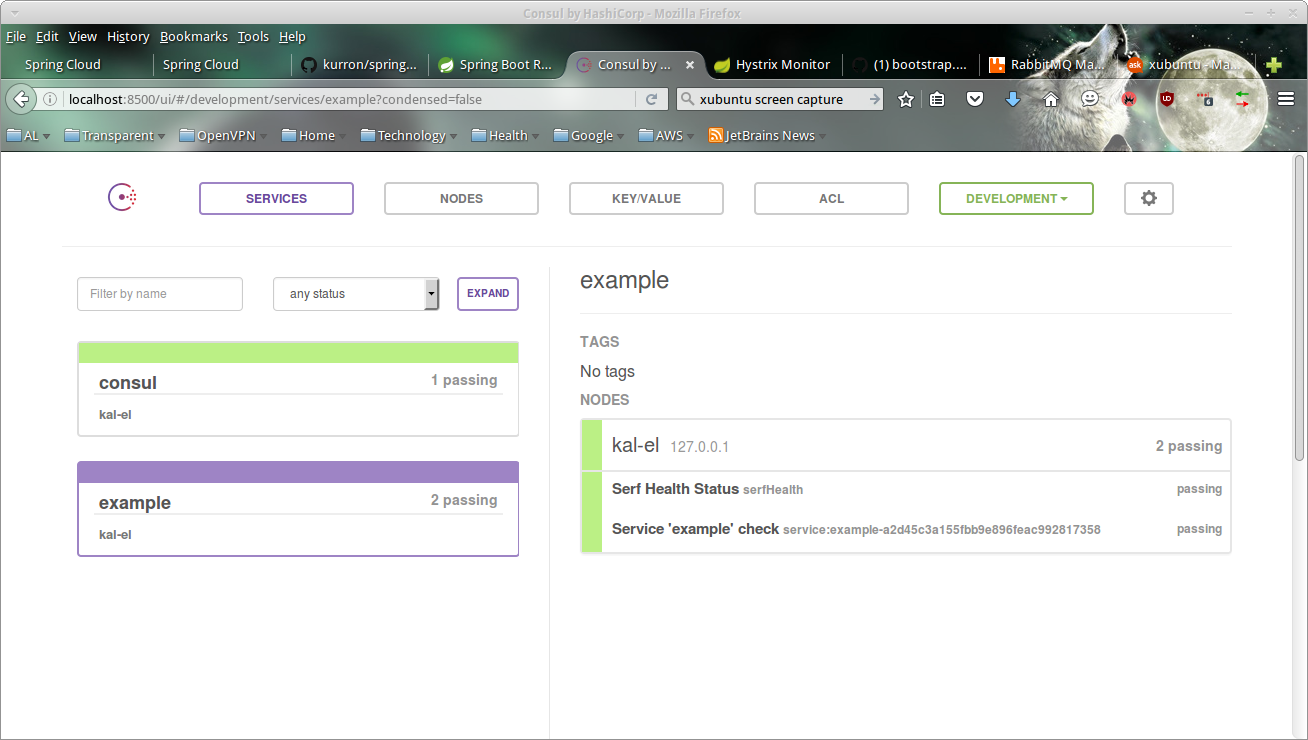
Service Discovery
// src/main/groovy/org/kurron/example/Application.groovy
@SpringBootApplication
@EnableCircuitBreaker
@EnableHystrixDashboard
@EnableTurbine
@EnableDiscoveryClient <---- magic incantation
@EnableConfigurationProperties( ApplicationProperties )
class Application {
static void main( String[] args ) {
SpringApplication.run( Application, args )
}
}Service Discovery
def 'call service by hand'() {
given: 'a proper testing environment'
assert serviceName <----- injected by Spring
assert discoveryClient <----- injected by Spring
when: 'we call checkTheTime'
def template = new TestRestTemplate()
//WARNING: this call can come back empty/null!
def instances = discoveryClient.getInstances( serviceName )
def chosen = randomElement( instances ) as ServiceInstance
def uri = constructURI( chosen, '/descriptor/application' )
ResponseEntity<String> response = template.getForEntity( uri, String )
then: 'we get a proper response'
response.statusCode == HttpStatus.OK
}
URI constructURI( ServiceInstance service, String path ) {
UriComponentsBuilder.newInstance()
.scheme( 'http' )
.host( service.host )
.port( service.port )
.path( path )
.build().toUri()
}Service Discovery
def 'call service using load balancer'() {
given: 'a proper testing environment'
assert serviceName <--- we use a logical name, not a host name
assert loadBalancer <-- watches Consul for health changes
when: 'we call checkTheTime'
def template = new TestRestTemplate()
def chosen = Optional.ofNullable( loadBalancer.choose( serviceName ) )
def uri = constructURI( chosen.orElseThrow( unavailableLogic ), '/descriptor/application' )
ResponseEntity<String> response = template.getForEntity( uri, String )
then: 'we get a proper response'
response.statusCode == HttpStatus.OK
}
def unavailableLogic = { new RuntimeException( 'No service instances!' ) }
URI constructURI( ServiceInstance service, String path ) {
UriComponentsBuilder.newInstance()
.scheme( 'http' )
.host( service.host )
.port( service.port )
.path( path )
.build().toUri()
}Load Balancing
- Ribbon is Netflix's client-side load balancer.
- Feign is Netflix's delcarative REST client that bundles in load-balancing, retry logic, circuit-breakers and RxJava support.
- Using RestTemplate means that we have to bake in all those features ourselves. Options include Groovy meta-programming, Java Aspects or by hand implementation of the RestOperations interface.
Routing
- Feign is a Netflix abstraction that combines best practices into a single solution.
- service discovery
- load balancing
- circuit-breakers
- timeouts
- bulk-heading
- delcarative HTTP client
Routing
@Category( OutboundIntegrationTest )
@IntegrationTest
@ContextConfiguration( classes = FeignIntegrationTestConfiguration,
loader = SpringApplicationContextLoader )
class FeignIntegrationTest extends Specification implements GenerationAbility {
@Autowired
private RestGatewayClient client <---- resource-specific client
def 'call happy path'() {
given: 'a proper testing environment'
assert client
when: 'we call happyPath'
def results = client.happyPath() <---- convenience method
then: 'we get a proper response'
results
println results
}
}
Routing
@FeignClient( name = 'example', <---- logical service name
configuration = RestGatewayClientConfiguration.
fallback = RestGatewayClientFallback ) <---- fallback logic
interface RestGatewayClient {
@RequestMapping( method = RequestMethod.GET,
path = '/descriptor/application',
consumes = 'application/json' )
String happyPath()
@RequestMapping( method = RequestMethod.GET,
path = '/descriptor/fail',
consumes = 'application/json' )
String systemFailure()
@RequestMapping( method = RequestMethod.GET,
path = '/descriptor/fail/application',
consumes = 'application/json' )
String applicationFailure()
}Routing
class RestGatewayClientFallback implements RestGatewayClient {
@Override
String happyPath() {
'happyPath fallback returned'
}
@Override
String systemFailure() {
'systemFailure fallback returned'
}
@Override
String applicationFailure() {
'applicationFailure fallback returned'
}
}Routing
@Configuration
class RestGatewayClientConfiguration {
@Bean
RestGatewayClientFallback restGatewayClientFallback() {
new RestGatewayClientFallback()
}
@Bean
Logger.Level feignLoggerLevel() {
Logger.Level.FULL
}
@Bean
CustomErrorDecoder customErrorDecoder() {
new CustomErrorDecoder()
}
@Bean
Request.Options requestOptions() {
int connectionTimeout = 1000
int readTimeout = 1000
new Request.Options( connectionTimeout, readTimeout )
}
@Bean
RequestInterceptor customRequestInterceptor() {
{ RequestTemplate template ->
template.header( 'X-Custom-Header', Instant.now().toString() )
} as RequestInterceptor
}
}Routing
Zuul is the front door for all requests from devices and web sites to the backend of the Netflix streaming application. As an edge service application, Zuul is built to enable dynamic routing, monitoring, resiliency and security. It also has the ability to route requests to multiple Amazon Auto Scaling Groups as appropriate.
Routing
- Authentication and Security - identifying authentication requirements for each resource and rejecting requests that do not satisfy them.
- Insights and Monitoring - tracking meaningful data and statistics at the edge in order to give us an accurate view of production.
- Dynamic Routing - dynamically routing requests to different backend clusters as needed.
- Stress Testing - gradually increasing the traffic to a cluster in order to gauge performance.
Routing
- Load Shedding - allocating capacity for each type of request and dropping requests that go over the limit.
- Static Response handling - building some responses directly at the edge instead of forwarding them to an internal cluster
- Multiregion Resiliency - routing requests across AWS regions in order to diversify our ELB usage and move our edge closer to our members
Routing
Routing
@SpringBootApplication
@EnableZuulProxy <---- embeds the proxy
@EnableConfigurationProperties( ApplicationProperties )
class Application {
static void main( String[] args ) {
SpringApplication.run( Application, args )
}
}Routing
zuul:
routes:
users:
path: /myusers/** <---- the path getting proxied
serviceId: users_service <---- service name in Consul
sensitiveHeaders: Cookie,Set-Cookie,Authorization
# more elaborate configuration is required if circuit-breakers are desiredRouting
# Example of API strangulation
zuul:
routes:
first: <---- send traffic to external URL
path: /first/**
url: http://first.example.com
second: <---- send traffic to internal /second service
path: /second/**
url: forward:/second
third: <---- send traffic to internal /3rd service
path: /third/**
url: forward:/3rd
legacy: <---- default to the old system
path: /**
url: http://legacy.example.comDistributed Messaging
Spring Cloud Bus links nodes of a distributed system with a lightweight message broker. This can then be used to broadcast state changes (e.g. configuration changes) or other management instructions. A key idea is that the Bus is like a distributed Actuator for a Spring Boot application that is scaled out, but it can also be used as a communication channel between apps. The only implementation currently is with an AMQP broker as the transport, but the same basic feature set (and some more depending on the transport) is on the roadmap for other transports.
Distributed Messaging
- Spring Cloud Bus integrates with GitHub, GitLab and Bitbucket to monitor changes in the configuration repository and automatically push out notifications to applications that they should refresh their configurations
- The bus currently supports sending messages to all nodes listening or all nodes for a particular service.
Distributed Messaging
Spring Cloud Stream is a framework for building message-driven microservices. Spring Cloud Stream builds upon Spring Boot to create DevOps friendly microservice applications and Spring Integration to provide connectivity to message brokers. Spring Cloud Stream provides an opinionated configuration of message brokers, introducing the concepts of persistent pub/sub semantics, consumer groups and partitions across several middleware vendors. This opinionated configuration provides the basis to create stream processing applications.
Distributed Messaging
- RabbitMQ
- Redis
- Kafka
- Gemfire
- Amazon SQS?
- Simple to set up and use
- a consumer group deals with the competing consumer problem -- only one instance in the group will get the message
- partitioning is "sticky" routing of messages where stateful processing is important
- Spring Integration under the hood
Distributed Messaging
@Slf4j
@OutboundGateway
@EnableBinding( Source ) <---- magic incantation
class StreamProducer implements GenerationAbility{
@InboundChannelAdapter( Source.OUTPUT )
public String send() {
def message = "Hello, World. It is ${Instant.now().toString()}"
log.info( 'Sending {}', message )
message
}
}
// we could have sent an object and had Spring auto-transform it into JSON
// we can also assemble messages by hand if we need more control, e.g. headersDistributed Messaging
Slf4j
@InboundGateway
@EnableBinding( Sink )
class StreamGateway {
@StreamListener( Sink.INPUT )
void processMessage( String request ) {
log.info( 'Hearing {}', request )
}
}
// we could have accepted an object and had Spring auto-transform it from JSONDistributed Messaging
# example-default.yml on the configuration server
spring:
cloud:
stream:
bindings:
input: <---- this is the channel name in the code
destination: rendezous <---- RabbitMQ exchange to use
group: example
contentType: text/plain
consumer:
concurrency: 1
partitioned: false
maxAttempts: 3
backOffInitialInterval: 1000
backOffMaxInterval: 10000
backOffMultiplier: 2.0
acknowledgeMode: AUTO
autoBindDlq: true
durableSubscription: true
maxConcurrency: 1
prefetch: 1
prefix: ${spring.application.name}.
requeueRejected: true
republishToDlq: true
transacted: false
txSize: 1
output: <---- this is the channel name in the code
destination: rendezous <---- RabbitMQ exchange to use
contentType: text/plain
producer:
autoBindDlq: true
batchingEnabled: false
batchSize: 100
batchBufferLimit: 1000
batchTimeout: 5000
compress: false
deliveryMode: PERSISTENT
prefix: ${spring.application.name}.
Distributed Messaging
http localhost:8080/operations/health
HTTP/1.1 200 OK
Content-Type: application/json;charset=UTF-8
Date: Mon, 28 Mar 2016 23:54:03 GMT
Server: Apache-Coyote/1.1
Transfer-Encoding: chunked
X-Application-Context: example:8080
X-B3-Sampled: 0
X-B3-SpanId: 64740575bcecba80
X-B3-TraceId: 64740575bcecba80
{
"binders": { <---- all the brokers Spring Cloud Stream is bound to
"rabbit": {
"binderHealthIndicator": {
"status": "UP",
"version": "3.6.1"
},
"status": "UP"
},
"status": "UP"
},
"configServer": {
"propertySources": [
"https://github.com/kurron/spring-configuration-files.git/application.yml"
],
"status": "UP"
},
"description": "Spring Cloud Consul Discovery Client",
"discoveryComposite": {
"description": "Spring Cloud Consul Discovery Client",
"discoveryClient": {
"description": "Spring Cloud Consul Discovery Client",
"services": [
"consul",
"example"
],
"status": "UP"
},
"status": "UP"
},
"diskSpace": {
"free": 25699893248,
"status": "UP",
"threshold": 10485760,
"total": 39233855488
},
"hystrix": {
"status": "UP"
},
"rabbit": {
"status": "UP",
"version": "3.6.1"
},
"refreshScope": {
"status": "UP"
},
"status": "UP"
}
Service-To-Service Calls
While Spring Cloud Stream makes it easy for individual boot apps to connect to messaging systems, the typical scenario for Spring Cloud Stream is the creation of multi-app pipelines, where microservice apps are sending data to each other. This can be achieved by correlating the input and output destinations of adjacent apps.
- instance counting and instance indexing help deal with scale out
- partition targeting ensures data arrives at its intended destination, regardless of the size of the cluster
Circuit-Breakers

Circuit-Breakers

Circuit-Breakers
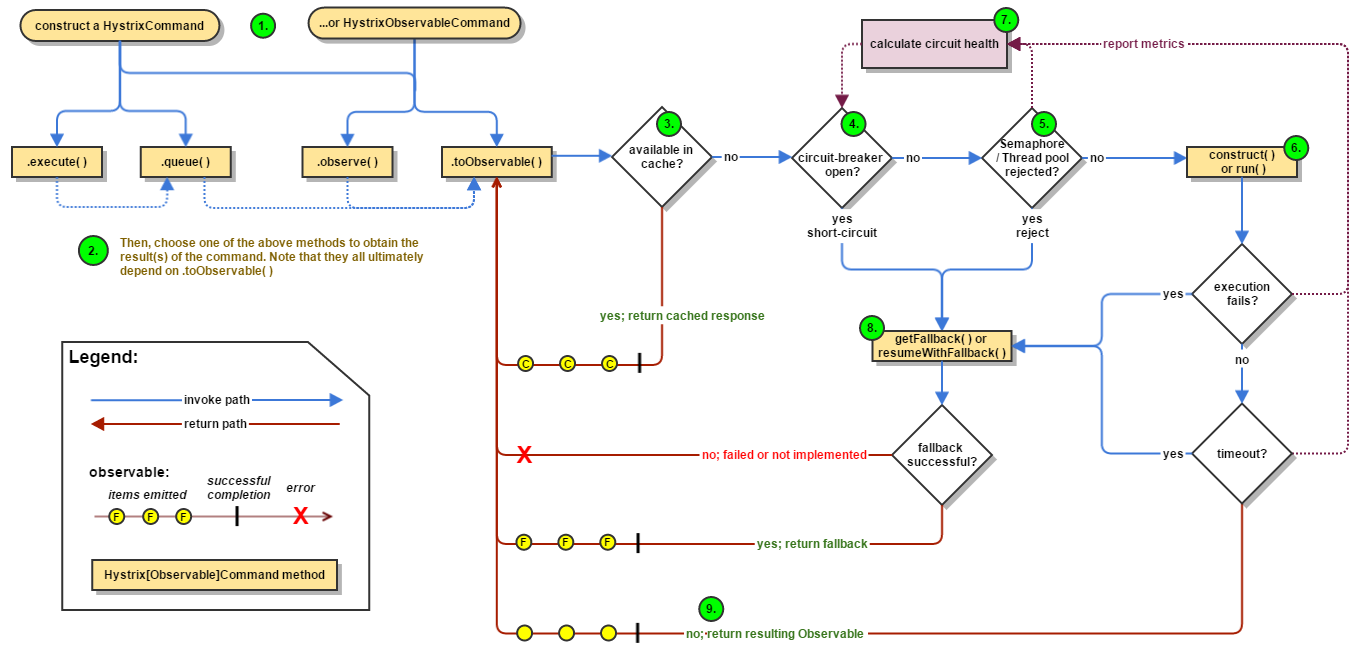
Uses Netflix's Hystrix library
Circuit-Breakers
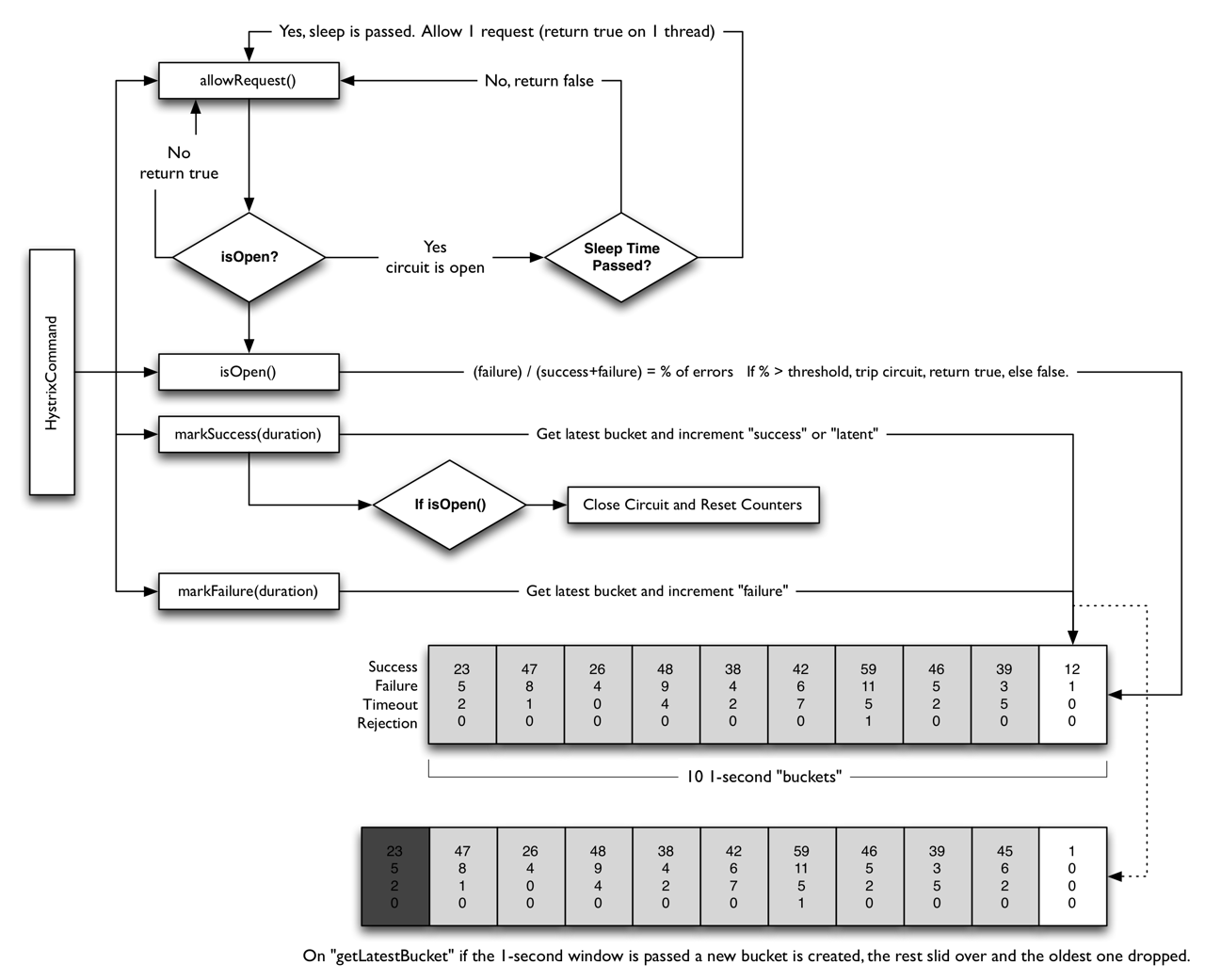
Circuit-Breakers
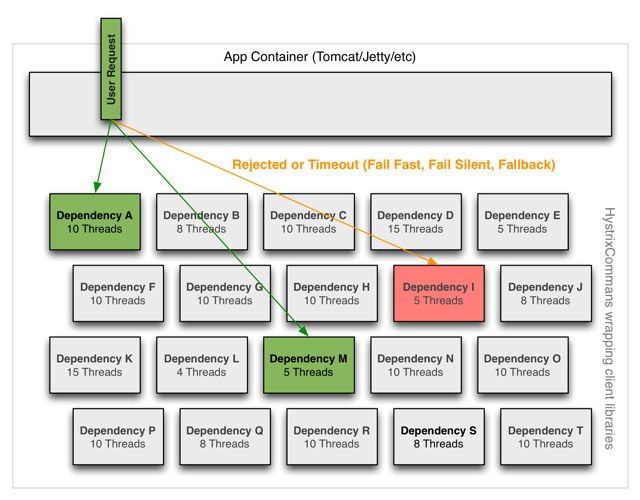
Bulkheading provides isolation
Circuit-Breakers
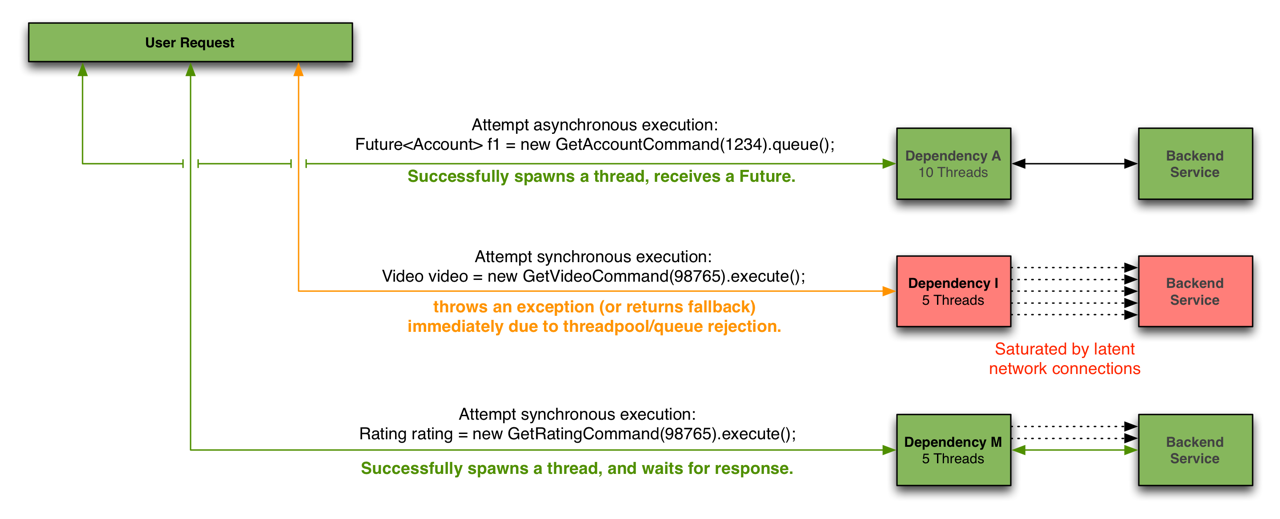
- load shedding
- timeout
Circuit-Breakers
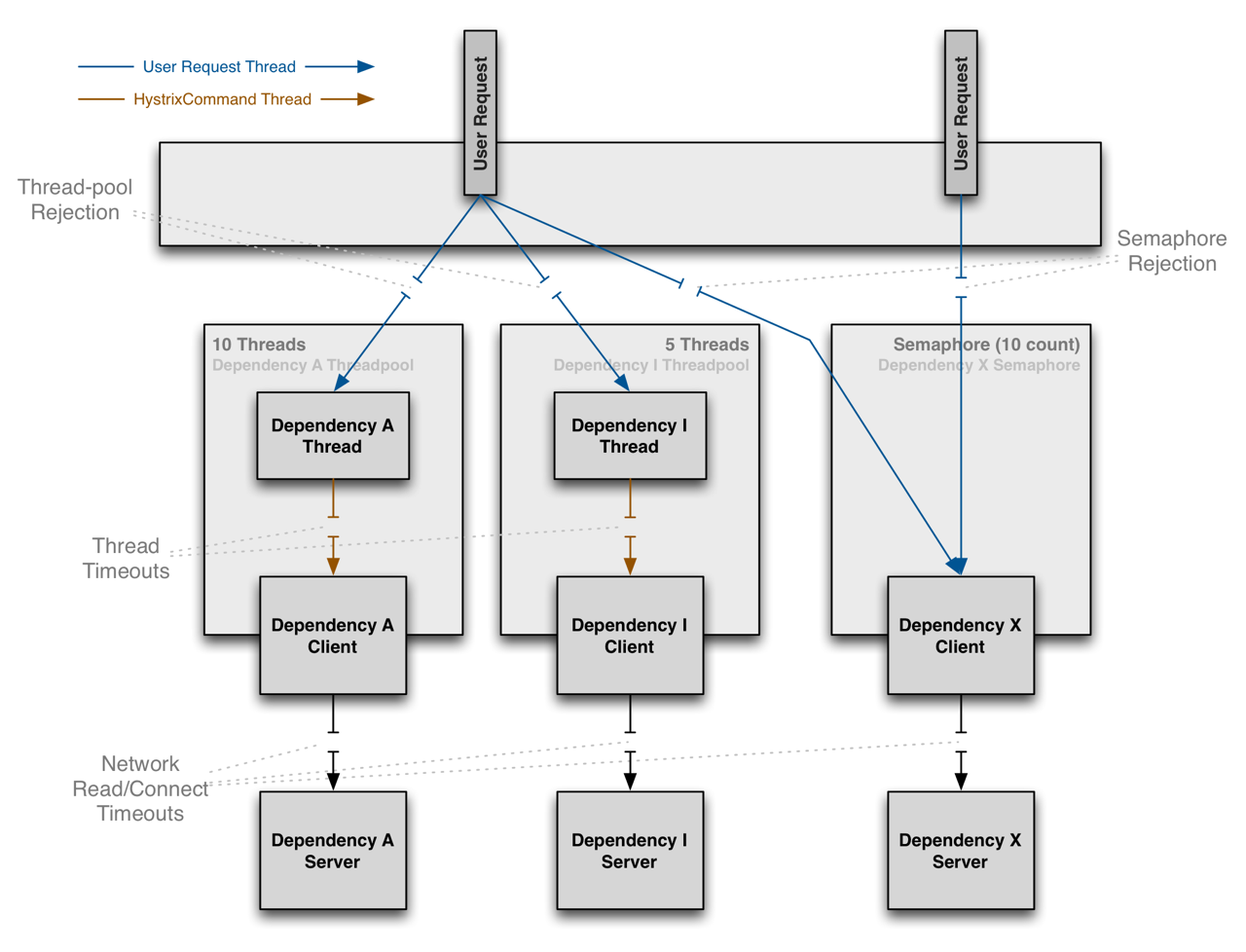
- load shedding via counters
- no timeouts
Circuit-Breakers

- request caching
- deduplication
Circuit-Breakers
@Slf4j
@SpringBootApplication
@EnableCircuitBreaker <---- magic incantation
@EnableHystrixDashboard
@EnableTurbine
@EnableDiscoveryClient
@EnableConfigurationProperties( ApplicationProperties )
class Application {
static void main( String[] args ) {
SpringApplication.run( Application, args )
}
}Circuit-Breakers
@OutboundGateway
class RemoteTimeGateway implements TimeService {
@HystrixCommand( fallbackMethod = 'defaultTime' ) <--- magic
Instant checkTheTime() {
// force an error to trigger the circuit-breaker
throw = new UnsupportedOperationException( 'checkTime' )
}
// You don't have to provide a fallback
private Instant defaultTime() {
// can't reach the time server, use local time instead
Instant.now()
}
}We're jumping threads so some thought has to be given if thread-specific context needs to be propogated
Circuit-Breakers
{
"hystrix": {
"openCircuitBreakers": [
"RemoteTimeGateway::checkTheTime"
],
"status": "CIRCUIT_OPEN" <---- not getting to the service
},
"rabbit": {
"status": "UP",
"version": "3.6.1"
},
"status": "UP" <---- up because we have fallbacks in place
}
- Health check reflects any open breakers
- Notice overall health is still UP
Circuit-Breakers
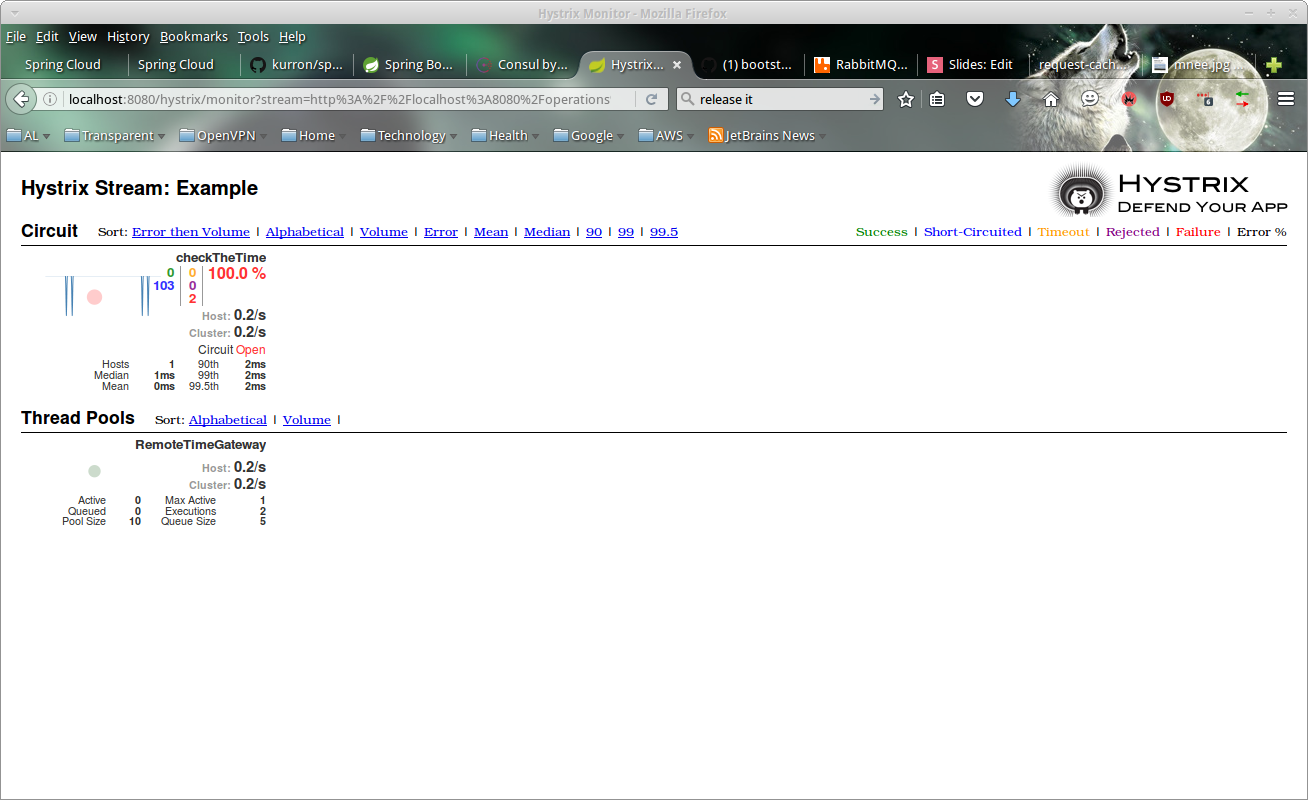
Each service can host its own dashboard
Circuit-Breakers
Turbine aggregates breaker data into one panel
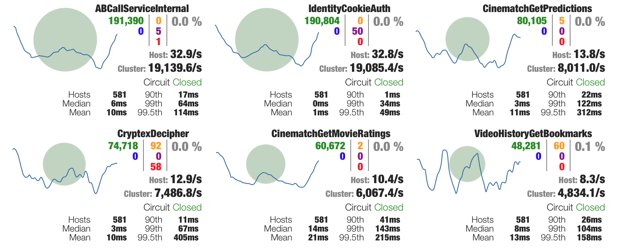
Security
Spring Cloud Security offers a set of primitives for building secure applications and services with minimum fuss. A declarative model which can be heavily configured externally (or centrally) lends itself to the implementation of large systems of co-operating, remote components, usually with a central indentity management service. It is also extremely easy to use in a service platform like Cloud Foundry. Building on Spring Boot and Spring Security OAuth2 we can quickly create systems that implement common patterns like single sign on, token relay and token exchange.
Security
@SpringBootApplication
@EnableOAuth2Sso <---- Turns on OAuth2 single sign on
@EnableResourceServer <---- Makes this application a resource server
@EnableAuthorizationServer <---- Make this application an authorization server
@EnableConfigurationProperties( ApplicationProperties )
class Application {
static void main( String[] args ) {
SpringApplication.run( Application, args )
}
}Security
- never got the GitHub example fully working
- can run our own OAuth2 servers, if desired
- Spring has an OAuth2RestTemplate that automatically does the token management for us
Metrics
http http://10.0.2.15:8080/operations/metrics --pretty=format
HTTP/1.1 200 OK
Content-Type: application/json;charset=UTF-8
Date: Sun, 27 Mar 2016 22:41:26 GMT
Server: Apache-Coyote/1.1
Transfer-Encoding: chunked
X-Application-Context: example:8080
{
"classes": 12101,
"classes.loaded": 12101,
"classes.unloaded": 0,
"currentTimeCounter(type=NORMALIZED)": 0.016666666666666666,
"currentTimeDistribution(statistic=count)": 13.0,
"currentTimeDistribution(statistic=totalAmount)": 4.2259077013282903e+18,
"currentTimeTimer(statistic=count)": 0.016666666666666666,
"currentTimeTimer(statistic=max)": 0.365126288,
"currentTimeTimer(statistic=totalOfSquares)": 0.13331720618865894,
"currentTimeTimer(statistic=totalTime)": 0.006085438133333334,
"gc.ps_marksweep.count": 3,
"gc.ps_marksweep.time": 336,
"gc.ps_scavenge.count": 17,
"gc.ps_scavenge.time": 225,
"heap": 1359872,
"heap.committed": 550400,
"heap.init": 96256,
"heap.used": 350533,
"httpsessions.active": 0,
"httpsessions.max": -1,
"hystrix.HystrixCommand.RemoteTimeGateway.checkTheTime.0()": 2.0,
"hystrix.HystrixCommand.RemoteTimeGateway.checkTheTime.100()": 12.0,
"hystrix.HystrixCommand.RemoteTimeGateway.checkTheTime.25()": 2.0,
"hystrix.HystrixCommand.RemoteTimeGateway.checkTheTime.50()": 4.0,
"hystrix.HystrixCommand.RemoteTimeGateway.checkTheTime.75()": 7.0,
"hystrix.HystrixCommand.RemoteTimeGateway.checkTheTime.90()": 11.0,
"hystrix.HystrixCommand.RemoteTimeGateway.checkTheTime.95()": 11.0,
"hystrix.HystrixCommand.RemoteTimeGateway.checkTheTime.99()": 12.0,
"hystrix.HystrixCommand.RemoteTimeGateway.checkTheTime.99.5()": 12.0,
"hystrix.HystrixCommand.RemoteTimeGateway.checkTheTime.currentConcurrentExecutionCount()": 0.0,
"hystrix.HystrixCommand.RemoteTimeGateway.checkTheTime.errorCount()": 8.0,
"hystrix.HystrixCommand.RemoteTimeGateway.checkTheTime.errorPercentage()": 100.0,
"hystrix.HystrixCommand.RemoteTimeGateway.checkTheTime.latencyExecute_mean()": 5.0,
"hystrix.HystrixCommand.RemoteTimeGateway.checkTheTime.latencyTotal_mean()": 5.0,
"hystrix.HystrixCommand.RemoteTimeGateway.checkTheTime.propertyValue_circuitBreakerErrorThresholdPercentage()": 50.0,
"hystrix.HystrixCommand.RemoteTimeGateway.checkTheTime.propertyValue_circuitBreakerRequestVolumeThreshold()": 20.0,
"hystrix.HystrixCommand.RemoteTimeGateway.checkTheTime.propertyValue_circuitBreakerSleepWindowInMilliseconds()": 5000.0,
"hystrix.HystrixCommand.RemoteTimeGateway.checkTheTime.propertyValue_executionIsolationSemaphoreMaxConcurrentRequests()": 10.0,
"hystrix.HystrixCommand.RemoteTimeGateway.checkTheTime.propertyValue_executionIsolationThreadTimeoutInMilliseconds()": 1000.0,
"hystrix.HystrixCommand.RemoteTimeGateway.checkTheTime.propertyValue_executionTimeoutInMilliseconds()": 1000.0,
"hystrix.HystrixCommand.RemoteTimeGateway.checkTheTime.propertyValue_fallbackIsolationSemaphoreMaxConcurrentRequests()": 10.0,
"hystrix.HystrixCommand.RemoteTimeGateway.checkTheTime.propertyValue_metricsRollingStatisticalWindowInMilliseconds()": 10000.0,
"hystrix.HystrixCommand.RemoteTimeGateway.checkTheTime.reportingHosts()": 1.0,
"hystrix.HystrixCommand.RemoteTimeGateway.checkTheTime.requestCount()": 8.0,
"hystrix.HystrixCommand.RemoteTimeGateway.checkTheTime.rollingCountBadRequests()": 0.0,
"hystrix.HystrixCommand.RemoteTimeGateway.checkTheTime.rollingCountCollapsedRequests()": 0.0,
"hystrix.HystrixCommand.RemoteTimeGateway.checkTheTime.rollingCountEmit()": 0.0,
"hystrix.HystrixCommand.RemoteTimeGateway.checkTheTime.rollingCountExceptionsThrown()": 0.0,
"hystrix.HystrixCommand.RemoteTimeGateway.checkTheTime.rollingCountFailure()": 8.0,
"hystrix.HystrixCommand.RemoteTimeGateway.checkTheTime.rollingCountFallbackEmit()": 0.0,
"hystrix.HystrixCommand.RemoteTimeGateway.checkTheTime.rollingCountFallbackFailure()": 0.0,
"hystrix.HystrixCommand.RemoteTimeGateway.checkTheTime.rollingCountFallbackMissing()": 0.0,
"hystrix.HystrixCommand.RemoteTimeGateway.checkTheTime.rollingCountFallbackRejection()": 0.0,
"hystrix.HystrixCommand.RemoteTimeGateway.checkTheTime.rollingCountFallbackSuccess()": 8.0,
"hystrix.HystrixCommand.RemoteTimeGateway.checkTheTime.rollingCountResponsesFromCache()": 0.0,
"hystrix.HystrixCommand.RemoteTimeGateway.checkTheTime.rollingCountSemaphoreRejected()": 0.0,
"hystrix.HystrixCommand.RemoteTimeGateway.checkTheTime.rollingCountShortCircuited()": 0.0,
"hystrix.HystrixCommand.RemoteTimeGateway.checkTheTime.rollingCountSuccess()": 0.0,
"hystrix.HystrixCommand.RemoteTimeGateway.checkTheTime.rollingCountThreadPoolRejected()": 0.0,
"hystrix.HystrixCommand.RemoteTimeGateway.checkTheTime.rollingCountTimeout()": 0.0,
"hystrix.HystrixCommand.RemoteTimeGateway.checkTheTime.rollingMaxConcurrentExecutionCount()": 1.0,
"hystrix.HystrixThreadPool.RemoteTimeGateway.currentActiveCount()": 0.0,
"hystrix.HystrixThreadPool.RemoteTimeGateway.currentCompletedTaskCount()": 13.0,
"hystrix.HystrixThreadPool.RemoteTimeGateway.currentCorePoolSize()": 10.0,
"hystrix.HystrixThreadPool.RemoteTimeGateway.currentLargestPoolSize()": 10.0,
"hystrix.HystrixThreadPool.RemoteTimeGateway.currentMaximumPoolSize()": 10.0,
"hystrix.HystrixThreadPool.RemoteTimeGateway.currentPoolSize()": 10.0,
"hystrix.HystrixThreadPool.RemoteTimeGateway.currentQueueSize()": 0.0,
"hystrix.HystrixThreadPool.RemoteTimeGateway.currentTaskCount()": 13.0,
"hystrix.HystrixThreadPool.RemoteTimeGateway.propertyValue_metricsRollingStatisticalWindowInMilliseconds()": 10000.0,
"hystrix.HystrixThreadPool.RemoteTimeGateway.propertyValue_queueSizeRejectionThreshold()": 5.0,
"hystrix.HystrixThreadPool.RemoteTimeGateway.reportingHosts()": 1.0,
"hystrix.HystrixThreadPool.RemoteTimeGateway.rollingCountCommandRejections()": 0.0,
"hystrix.HystrixThreadPool.RemoteTimeGateway.rollingCountThreadsExecuted()": 8.0,
"hystrix.HystrixThreadPool.RemoteTimeGateway.rollingMaxActiveThreads()": 1.0,
"instance.uptime": 480861,
"mem": 644575,
"mem.free": 199866,
"nonheap": 0,
"nonheap.committed": 96384,
"nonheap.init": 2496,
"nonheap.used": 94175,
"processors": 2,
"response.descriptor.application()": 8.0,
"response.operations.health()": 248.0,
"response.operations.metrics()": 30.0,
"systemload.average": 0.4,
"threads": 48,
"threads.daemon": 36,
"threads.peak": 48,
"threads.totalStarted": 79,
"uptime": 491444
}Metrics
- Netflix has a metrics library called Spectator
- It provides counters, timers, gauges and distribution summaries
- Netflix has a metrics back end called Atlas
An Atlas standalone node running on an r3.2xlarge (61GB RAM) can handle roughly 2 million metrics per minute for a given 6 hour window.
Metrics
@SpringBootApplication
@EnableCircuitBreaker
@EnableHystrixDashboard
@EnableTurbine
@EnableDiscoveryClient
@EnableFeignClients
@EnableAtlas <---- magic incantation
@EnableConfigurationProperties( ApplicationProperties )
class Application {
static void main( String[] args ) {
SpringApplication.run( Application, args )
}
@Bean
AtlasTagProvider atlasCommonTags( @Value( '${spring.application.name}' ) String appName ) {
[ 'defaultTags': { ['app': appName] } ] as AtlasTagProvider
}
}Metrics
/**
* Metrics collector.
*/
private final Registry registry
@Override
Instant currentTime() {
// the timer also counts so this is redundant
def counter = registry.counter( 'currentTimeCounter' )
counter.increment()
// contrived example: normally this is used to record some incoming value
def distribution = registry.distributionSummary( 'currentTimeDistribution' )
distribution.record( randomLong() )
// gauges, which track the current number of something, like queue size, are also available
def timer = registry.timer( 'currentTimeTimer' )
// in a real implementation we would interact with multiple services and take
// the best result but this is only an example
// The timer simultaneously records 4 statistics: count, max, totalOfSquares, and totalTime.
timer.record( { gateway.checkTheTime() } as Callable<Instant> )
}
Metrics
# shared application.yml
netflix:
atlas:
uri: http://localhost:7101 <---- location of the Atlas instance
Metrics

/api/v1/graph?
e=2012-01-01T00:00
&no_legend=1
&q=
name,sps,:eq,
(,nf.cluster,),:by,
:pct,
:stack
&s=e-1wDistributed Tracing
- distributed tracing is complicated
- Google wrote "Dapper, a Large-Scale Distributed Systems Tracing Infrastructure"
- Twitter implemented it in their Zipkin framework
- Spring Sleuth is a Dapper compatible abstraction that can integrate with a couple back-ends, including Zipkin
Distributed Tracing
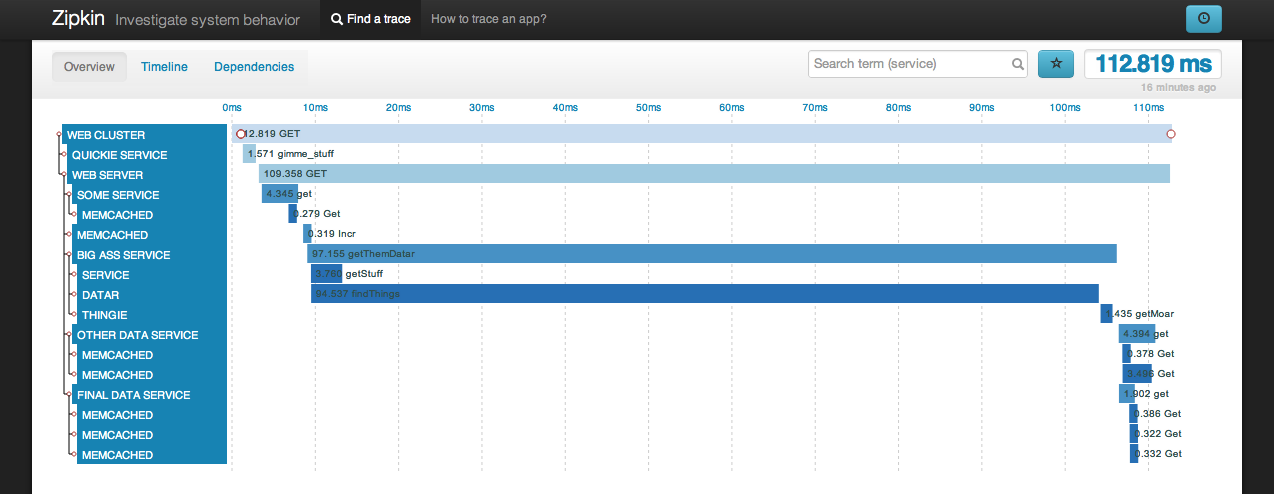
Distributed Tracing
Span: The basic unit of work. For example, sending an RPC is a new span, as is sending a response to an RPC. Span’s are identified by a unique 64-bit ID for the span and another 64-bit ID for the trace the span is a part of. Spans also have other data, such as descriptions, timestamped events, key-value annotations (tags), the ID of the span that caused them, and process ID’s (normally IP address).
Spans are started and stopped, and they keep track of their timing information. Once you create a span, you must stop it at some point in the future.
Distributed Tracing
Trace: A set of spans forming a tree-like structure. For example, if you are running a distributed big-data store, a trace might be formed by a put request.
Distributed Tracing
Annotation: is used to record existence of an event in time. Some of the core annotations used to define the start and stop of a request are:
cs - Client Sent - The client has made a request. This annotation depicts the start of the span.
sr - Server Received - The server side got the request and will start processing it. If one subtracts the cs timestamp from this timestamp one will receive the network latency.
Distributed Tracing
- ss - Server Sent - Annotated upon completion of request processing (when the response got sent back to the client). If one subtracts the sr timestamp from this timestamp one will receive the time needed by the server side to process the request.
- cr - Client Received - Signifies the end of the span. The client has successfully received the response from the server side. If one subtracts the cs timestamp from this timestamp one will receive the whole time needed by the client to receive the response from the server.
Distributed Tracing

Distributed Tracing

All this is under a single trace id
Distributed Tracing
- Spring automatically places interceptors on all inbound and outbound gateways
- Circuit-breakers
- HTTP filters
- RestTemplate
- Feign client
- Spring Integration
- Rabbit template?
- Zuul
Distributed Tracing
- log output can be searched via Kibana and Splunk
- Logstash grok pattern provided
- can output Zipkin compatible format
- can output to Spring Cloud Stream
- default output is to SLF4J
- can use sampling for high volume scenarios
- there is a manual API for special circumstances
- appears to be very customizable
Distributed Tracing
HTTP/1.1 200 OK
Content-Type: application/json; type=FIXME; version=1.0.0;charset=UTF-8
Date: Sun, 27 Mar 2016 23:15:57 GMT
Server: Apache-Coyote/1.1
Transfer-Encoding: chunked
X-Application-Context: example:8080
X-B3-Sampled: 1
X-B3-SpanId: 6fca525591c416be
X-B3-TraceId: 6fca525591c416be
{
"path": "/descriptor/application",
"status": 200,
"time": "2016-03-27T23:15:57.917Z",
"timestamp": "2016-03-27T23:15:57.562Z"
}
HTTP/1.1 200 OK
Content-Type: application/json; type=FIXME; version=1.0.0;charset=UTF-8
Date: Sun, 27 Mar 2016 23:16:00 GMT
Server: Apache-Coyote/1.1
Transfer-Encoding: chunked
X-Application-Context: example:8080
X-B3-Sampled: 1
X-B3-SpanId: 29882e8f3c43d283
X-B3-TraceId: 29882e8f3c43d283
{
"path": "/descriptor/application",
"status": 200,
"time": "2016-03-27T23:16:00.066Z",
"timestamp": "2016-03-27T23:16:00.048Z"
}
HTTP/1.1 200 OK
Content-Type: application/json; type=FIXME; version=1.0.0;charset=UTF-8
Date: Sun, 27 Mar 2016 23:22:18 GMT
Server: Apache-Coyote/1.1
Transfer-Encoding: chunked
X-Application-Context: example:8080
X-B3-Sampled: 1
X-B3-SpanId: 6db06cf2872894e
X-B3-TraceId: 6db06cf2872894e
{
"path": "/descriptor/application",
"status": 200,
"time": "2016-03-27T23:22:18.887Z",
"timestamp": "2016-03-27T23:22:18.881Z"
}
No code changes required
Global Locks
Never found documentation on how to do global locks.
Leadership Election
Spring Cloud Cluster offers a set of primitives for building "cluster" features into a distributed system. Example are leadership election, consistent storage of cluster state, global locks and one-time tokens.
- Zookeper
- Etcd
- Hazelcast
- Redis
- Consul?
Leadership Election
@InboundGateway
class ClusterEventListener implements ApplicationListener<AbstractLeaderEvent> {
@Override
void onApplicationEvent( AbstractLeaderEvent event ) {
switch ( event ) {
case OnGrantedEvent:
log.info( 'A new leader has been elected for role {}', event.role )
break
case OnRevokedEvent:
break
log.info( 'An old leader has been removed for role {}', event.role )
break
default:
log.info( 'Heard an unclassified event of type {}', event.class.name )
break
}
}
}
// Never got it to work with RedisCluster State
Never found any documentation on how to manage cluster state.
Polyglot Usage
- standalone JVM process
- service registration and discovery (Consul)
- load balancing (Ribbon)
- remote configuration
- if you need to have the sidecar register the service with Consul, you'll need a companion sidecar for each service
Polyglot Usage
@SpringBootApplication
@EnableSidecar <---- magic incantation
@EnableConfigurationProperties( ApplicationProperties )
class Application {
static void main( String[] args ) {
SpringApplication.run( Application, args )
}
}
dependencies {
compile('org.springframework.cloud:spring-cloud-starter-feign')
compile('org.springframework.cloud:spring-cloud-starter-ribbon')
compile('org.springframework.cloud:spring-cloud-starter-zuul')
compile('org.springframework.cloud:spring-cloud-netflix-sidecar') {
exclude module: 'spring-cloud-netflix-eureka-client'
exclude module: 'eureka-client'
exclude module: 'ribbon-eureka'
}
}Polyglot Usage
# src/main/resources/config/application.yml
info:
app:
name: ${name}
description: ${description}
version: ${version}
spring:
application:
name: configuration-service <---- non-JVM service name
sidecar:
port: 2020
health-uri: http://localhost:2020/operations/health <---- Consul checks thisPolyglot Usage
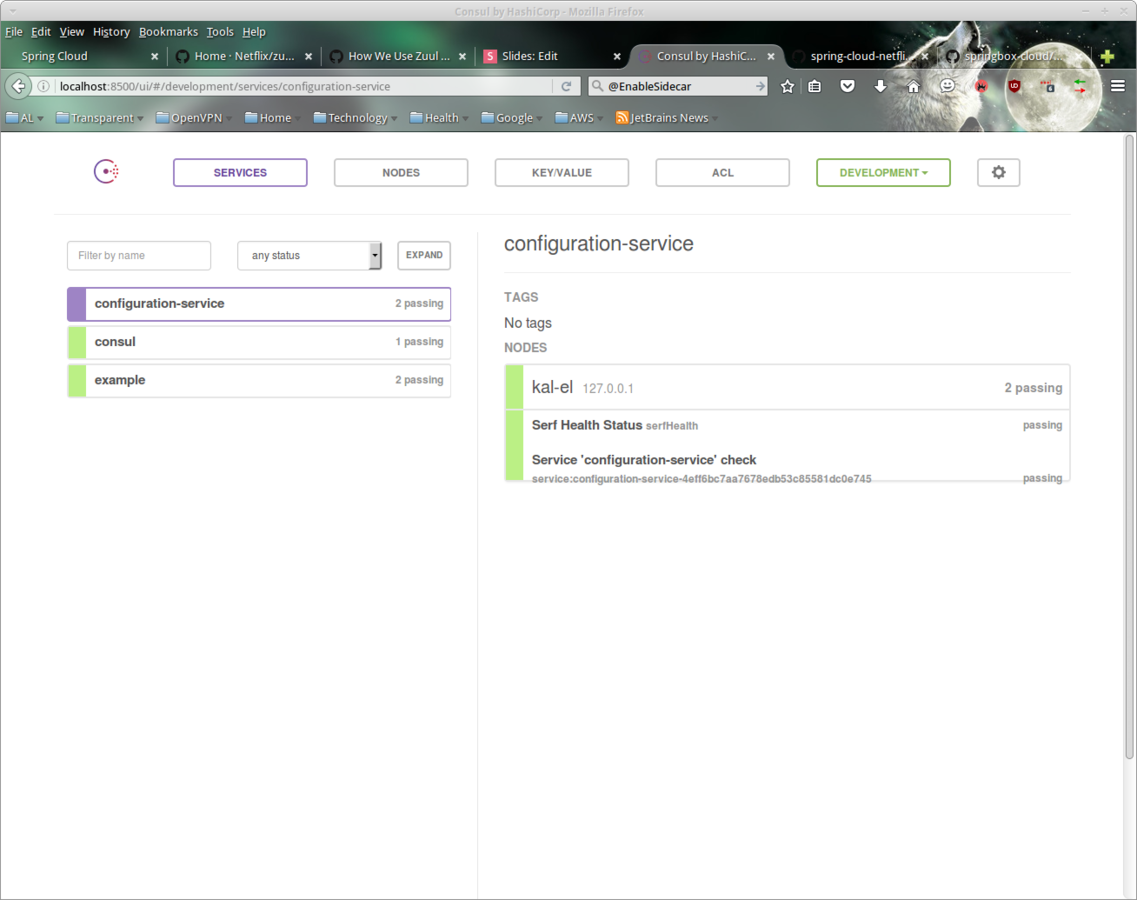
Polyglot Usage
http localhost:8080/hosts/configuration-service
HTTP/1.1 200 OK
Content-Type: application/json;charset=UTF-8
Date: Tue, 29 Mar 2016 21:30:18 GMT
Server: Apache-Coyote/1.1
Transfer-Encoding: chunked
X-Application-Context: configuration-service:8080
[
{
"host": "127.0.0.1",
"port": 8080,
"secure": false,
"serviceId": "configuration-service",
"uri": "http://127.0.0.1:8080" <---- points back to sidecar process
}
]
Polyglot Usage
http localhost:8080/example/descriptor/application <---- Zuul proxy
HTTP/1.1 200 OK
Content-Type: application/json; type=FIXME; version=1.0.0;charset=UTF-8
Date: Tue, 29 Mar 2016 21:44:05 GMT
Server: Apache-Coyote/1.1
Transfer-Encoding: chunked
X-Application-Context: configuration-service:8080
X-B3-Sampled: 1
X-B3-SpanId: 5dffc13065fde452
X-B3-TraceId: 5dffc13065fde452
{
"path": "/descriptor/application",
"status": 200,
"time": "2016-03-29T21:44:05.716Z",
"timestamp": "2016-03-29T21:44:05.370Z"
}
Polyglot Usage
http localhost:8080/hosts/example/
HTTP/1.1 200 OK
Content-Type: application/json;charset=UTF-8
Date: Wed, 30 Mar 2016 02:14:15 GMT
Server: Apache-Coyote/1.1
Transfer-Encoding: chunked
X-Application-Context: configuration-service:8080
[
{
"host": "127.0.0.1",
"port": 7070,
"secure": false,
"serviceId": "example",
"uri": "http://127.0.0.1:7070" <---- no proxy
},
{
"host": "127.0.0.1",
"port": 9090,
"secure": false,
"serviceId": "example",
"uri": "http://127.0.0.1:9090" <---- no proxy
}
]Polyglot Usage
http localhost:8080/CONFIGSERVER/example/default
HTTP/1.1 200 OK
Content-Type: application/json;charset=UTF-8
Date: Tue, 29 Mar 2016 22:36:51 GMT
Server: Apache-Coyote/1.1
Transfer-Encoding: chunked
X-Application-Context: configuration-service:8080
{
"name": "example",
"profiles": [
"default"
],
"propertySources": [
{
"name": "https://github.com/kurron/spring-configuration-files.git/example-default.yml",
"source": {
"example.deadLetterExchangeName": "dead-letter",
"example.deadLetterQueueName": "dead-letter",
"example.exchangeName": "some-exchange",
"example.foo": "default",
"example.inputChannelName": "my-input-channel",
"example.messageRetryAttempts": 3,
"example.queueName": "some-queue",
"sidecar.health-uri": "http://localhost:2020/operations/health",
"sidecar.port": 2020,
"spring.cloud.stream.bindings.input.consumer.acknowledgeMode": "AUTO",
"spring.cloud.stream.bindings.input.consumer.autoBindDlq": true,
"spring.cloud.stream.bindings.input.consumer.backOffInitialInterval": 1000,
"spring.cloud.stream.bindings.input.consumer.backOffMaxInterval": 10000,
"spring.cloud.stream.bindings.input.consumer.backOffMultiplier": 2.0,
"spring.cloud.stream.bindings.input.consumer.concurrency": 1,
"spring.cloud.stream.bindings.input.consumer.durableSubscription": true,
"spring.cloud.stream.bindings.input.consumer.maxAttempts": 3,
"spring.cloud.stream.bindings.input.consumer.maxConcurrency": 1,
"spring.cloud.stream.bindings.input.consumer.partitioned": false,
"spring.cloud.stream.bindings.input.consumer.prefetch": 1,
"spring.cloud.stream.bindings.input.consumer.prefix": "${spring.application.name}.",
"spring.cloud.stream.bindings.input.consumer.republishToDlq": true,
"spring.cloud.stream.bindings.input.consumer.requeueRejected": true,
"spring.cloud.stream.bindings.input.consumer.transacted": false,
"spring.cloud.stream.bindings.input.consumer.txSize": 1,
"spring.cloud.stream.bindings.input.contentType": "text/plain",
"spring.cloud.stream.bindings.input.destination": "rendezous",
"spring.cloud.stream.bindings.input.group": "example",
"spring.cloud.stream.bindings.output.contentType": "text/plain",
"spring.cloud.stream.bindings.output.destination": "rendezous",
"spring.cloud.stream.bindings.output.producer.autoBindDlq": true,
"spring.cloud.stream.bindings.output.producer.batchBufferLimit": 1000,
"spring.cloud.stream.bindings.output.producer.batchSize": 100,
"spring.cloud.stream.bindings.output.producer.batchTimeout": 5000,
"spring.cloud.stream.bindings.output.producer.batchingEnabled": false,
"spring.cloud.stream.bindings.output.producer.compress": false,
"spring.cloud.stream.bindings.output.producer.deliveryMode": "PERSISTENT",
"spring.cloud.stream.bindings.output.producer.prefix": "${spring.application.name}.",
"zuul.ignoredServices": "*",
"zuul.routes.first.path": "/first/**",
"zuul.routes.first.url": "http://first.example.com",
"zuul.routes.second.path": "/second/**",
"zuul.routes.second.url": "forward:/second",
"zuul.routes.third.path": "/third/**",
"zuul.routes.third.url": "forward:/3rd",
"zuul.routes.users.path": "/myusers/**",
"zuul.routes.users.sensitiveHeaders": "Cookie,Set-Cookie,Authorization",
"zuul.routes.users.serviceId": "users_service"
}
},
{
"name": "https://github.com/kurron/spring-configuration-files.git/application.yml",
"source": {
"applications": "${spring.application.name}",
"endpoints.health.sensitive": false,
"endpoints.health.time-to-live": 1000,
"logging.config": "classpath:logback.xml",
"management.contextPath": "/operations",
"management.security.enabled": false,
"management.security.role": "admin",
"management.security.sessions": "stateless",
"netflix.atlas.uri": "http://localhost:7101",
"security.basic.enabled": false,
"security.basic.realm": "example",
"security.user.name": "developer",
"security.user.password": "developer",
"server.contextPath": "/",
"server.port": 8080,
"server.tomcat.portHeader": "X-Forwarded-Port",
"server.tomcat.protocolHeader": "X-Forwarded-Protocol-Header",
"server.tomcat.remoteIpHeader": "X-Forwarded-Remote-IP-Header",
"server.useForwardHeaders": true,
"spring.cloud.cluster.leader.enabled": true,
"spring.cloud.cluster.leader.id": "Sponge Bob",
"spring.cloud.cluster.leader.role": "Master Of The Universe",
"spring.cloud.config.allowOverride": true,
"spring.cloud.config.failFast": true,
"spring.cloud.config.overrideNone": false,
"spring.cloud.config.overrideSystemProperties": false,
"spring.cloud.consul.discovery.healthCheckInterval": "15s",
"spring.cloud.consul.discovery.healthCheckPath": "${management.contextPath}/health",
"spring.cloud.consul.discovery.instanceId": "${spring.application.name}:${random.value}",
"spring.cloud.consul.discovery.preferAgentAddress": true,
"spring.cloud.consul.discovery.preferIpAddress": true,
"spring.cloud.consul.host": "localhost",
"spring.cloud.consul.port": 8500,
"spring.cloud.stream.rabbit.binder.addresses[0]": "localhost",
"spring.cloud.stream.rabbit.binder.adminAdresses[0]": "localhost",
"spring.cloud.stream.rabbit.binder.password": "guest",
"spring.cloud.stream.rabbit.binder.username": "guest",
"spring.cloud.stream.rabbit.binder.vhost": "/",
"spring.groovy.template.check-template-location": false,
"spring.inetutils.defaultHostname": "localhost",
"spring.inetutils.ignoredInterfaces[0]": "docker0",
"spring.inetutils.localhost": "127.0.0.1",
"spring.inetutils.timeoutSeconds": 1,
"spring.jackson.serialization-inclusion": "non_empty",
"spring.jackson.serialization.indent_output": true,
"spring.main.banner-mode": "console",
"spring.oauth2.client.accessTokenUri": "https://github.com/login/oauth/access_token",
"spring.oauth2.client.clientAuthenticationScheme": "form",
"spring.oauth2.client.clientId": "a1c5113ec74d4fc16c69",
"spring.oauth2.client.clientSecret": "aac122e5814095dc3525f1a19e5274353330f09d",
"spring.oauth2.client.userAuthorizationUri": "https://github.com/login/oauth/authorize",
"spring.oauth2.resource.preferTokenInfo": false,
"spring.oauth2.resource.userInfoUri": "https://api.github.com/user",
"spring.rabbitmq.host": "localhost",
"spring.rabbitmq.password": "guest",
"spring.rabbitmq.port": 5672,
"spring.rabbitmq.username": "guest",
"spring.rabbitmq.virtualHost": "/",
"turbine.aggregator.clusterConfig": "${applications}",
"turbine.appConfig": "${applications}"
}
}
],
"version": "527c752ddbfdd5b9f2f2c4862883fc5fd83668df"
}
Polyglot Usage
http localhost:8080/CONFIGSERVER/example-default.yml
HTTP/1.1 200 OK
Content-Type: text/plain;charset=UTF-8
Date: Wed, 30 Mar 2016 01:21:32 GMT
Server: Apache-Coyote/1.1
Transfer-Encoding: chunked
X-Application-Context: configuration-service:8080
spring:
cloud:
stream:
rabbit:
binder:
addresses:
- localhost
adminAdresses:
- localhost
password: guest
username: guest
vhost: /
bindings:
input:
consumer:
acknowledgeMode: AUTO
autoBindDlq: true
backOffInitialInterval: 1000
backOffMaxInterval: 10000
backOffMultiplier: 2.0
concurrency: 1
durableSubscription: true
maxAttempts: 3
maxConcurrency: 1
partitioned: false
prefetch: 1
prefix: ${spring.application.name}.
republishToDlq: true
requeueRejected: true
transacted: false
txSize: 1
contentType: text/plain
destination: rendezous
group: example
output:
contentType: text/plain
destination: rendezous
producer:
autoBindDlq: true
batchBufferLimit: 1000
batchSize: 100
batchTimeout: 5000
batchingEnabled: false
compress: false
deliveryMode: PERSISTENT
prefix: ${spring.application.name}.
cluster:
leader:
enabled: true
id: Sponge Bob
role: Master Of The Universe
config:
allowOverride: true
failFast: true
overrideNone: false
overrideSystemProperties: false
consul:
discovery:
healthCheckInterval: 15s
healthCheckPath: /operations/health
instanceId: ${spring.application.name}:${random.value}
preferAgentAddress: true
preferIpAddress: true
host: localhost
port: 8500
inetutils:
ignoredInterfaces:
- docker0
defaultHostname: localhost
localhost: 127.0.0.1
timeoutSeconds: 1
groovy:
template:
check-template-location: false
jackson:
serialization-inclusion: non_empty
serialization:
indent_output: true
main:
banner-mode: console
oauth2:
client:
accessTokenUri: https://github.com/login/oauth/access_token
clientAuthenticationScheme: form
clientId: a1c5113ec74d4fc16c69
clientSecret: aac122e5814095dc3525f1a19e5274353330f09d
userAuthorizationUri: https://github.com/login/oauth/authorize
resource:
preferTokenInfo: false
userInfoUri: https://api.github.com/user
rabbitmq:
host: localhost
password: guest
port: 5672
username: guest
virtualHost: /
applications: ${spring.application.name}
endpoints:
health:
sensitive: false
time-to-live: 1000
example:
deadLetterExchangeName: dead-letter
deadLetterQueueName: dead-letter
exchangeName: some-exchange
foo: default
inputChannelName: my-input-channel
messageRetryAttempts: 3
queueName: some-queue
logging:
config: classpath:logback.xml
management:
contextPath: /operations
security:
enabled: false
role: admin
sessions: stateless
netflix:
atlas:
uri: http://localhost:7101
security:
basic:
enabled: false
realm: example
user:
name: developer
password: developer
server:
contextPath: /
port: 8080
tomcat:
portHeader: X-Forwarded-Port
protocolHeader: X-Forwarded-Protocol-Header
remoteIpHeader: X-Forwarded-Remote-IP-Header
useForwardHeaders: true
sidecar:
health-uri: http://localhost:2020/operations/health
port: 2020
turbine:
aggregator:
clusterConfig: ${spring.application.name}
appConfig: ${spring.application.name}
zuul:
ignoredServices: '*'
routes:
first:
path: /first/**
url: http://first.example.com
second:
path: /second/**
url: forward:/second
third:
path: /third/**
url: forward:/3rd
users:
path: /myusers/**
sensitiveHeaders: Cookie,Set-Cookie,Authorization
serviceId: users_service
Polyglot Usage
http localhost:8080/CONFIGSERVER/example-bamboo.json
HTTP/1.1 200 OK
Content-Type: application/json;charset=UTF-8
Date: Wed, 30 Mar 2016 01:22:31 GMT
Server: Apache-Coyote/1.1
Transfer-Encoding: chunked
X-Application-Context: configuration-service:8080
{
"applications": "${spring.application.name}",
"endpoints": {
"health": {
"sensitive": false,
"time-to-live": 1000
}
},
"example": {
"foo": "bamboo"
},
"logging": {
"config": "classpath:logback.xml"
},
"management": {
"contextPath": "/operations",
"security": {
"enabled": false,
"role": "admin",
"sessions": "stateless"
}
},
"netflix": {
"atlas": {
"uri": "http://localhost:7101"
}
},
"security": {
"basic": {
"enabled": false,
"realm": "example"
},
"user": {
"name": "developer",
"password": "developer"
}
},
"server": {
"contextPath": "/",
"port": 8080,
"tomcat": {
"portHeader": "X-Forwarded-Port",
"protocolHeader": "X-Forwarded-Protocol-Header",
"remoteIpHeader": "X-Forwarded-Remote-IP-Header"
},
"useForwardHeaders": true
},
"spring": {
"cloud": {
"cluster": {
"leader": {
"enabled": true,
"id": "Sponge Bob",
"role": "Master Of The Universe"
}
},
"config": {
"allowOverride": true,
"failFast": true,
"overrideNone": false,
"overrideSystemProperties": false
},
"consul": {
"discovery": {
"healthCheckInterval": "15s",
"healthCheckPath": "/operations/health",
"instanceId": "${spring.application.name}:${random.value}",
"preferAgentAddress": true,
"preferIpAddress": true
},
"host": "localhost",
"port": 8500
},
"stream": {
"rabbit": {
"binder": {
"addresses": [
"localhost"
],
"adminAdresses": [
"localhost"
],
"password": "guest",
"username": "guest",
"vhost": "/"
}
}
}
},
"groovy": {
"template": {
"check-template-location": false
}
},
"inetutils": {
"defaultHostname": "localhost",
"ignoredInterfaces": [
"docker0"
],
"localhost": "127.0.0.1",
"timeoutSeconds": 1
},
"jackson": {
"serialization": {
"indent_output": true
},
"serialization-inclusion": "non_empty"
},
"main": {
"banner-mode": "console"
},
"oauth2": {
"client": {
"accessTokenUri": "https://github.com/login/oauth/access_token",
"clientAuthenticationScheme": "form",
"clientId": "a1c5113ec74d4fc16c69",
"clientSecret": "aac122e5814095dc3525f1a19e5274353330f09d",
"userAuthorizationUri": "https://github.com/login/oauth/authorize"
},
"resource": {
"preferTokenInfo": false,
"userInfoUri": "https://api.github.com/user"
}
},
"rabbitmq": {
"host": "localhost",
"password": "guest",
"port": 5672,
"username": "guest",
"virtualHost": "/"
}
},
"turbine": {
"aggregator": {
"clusterConfig": "${spring.application.name}"
},
"appConfig": "${spring.application.name}"
}
}
Closing
- Are there any tools or techniques we want to be using?
- In the JVM world, it would be a shame to not use this stuff
- Would side cars help or do we want to write our own implementations?